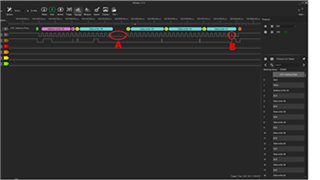- Ask a related questionWhat is a related question?A related question is a question created from another question. When the related question is created, it will be automatically linked to the original question.
This thread has been locked.
If you have a related question, please click the "Ask a related question" button in the top right corner. The newly created question will be automatically linked to this question.
Hi team,
Our customer use this device at follow condition.
Master: STM32
Slave: LP5036 only.
STM32 does the processing to update the part of internal register of LP5036 every 10ms.
But the I2C peripheral of STM32 detects an I2C bus error and stops after a few seconds to several tens of seconds.
The waveform below is I2C Bus signal when this problem caused.
We looks like clock stretching worked at A point in wave form.

Does this device have clock stretching function?
We can't find description about clock stretching in datasheet.
Best regards,
teritama
Hi Frank, Monet
I got more clear image of waveform.
We recognize two kinds of abnormal pulse in follow figure, A and B.
The clock frequency is 100kHz

Follow figure is overall. The waveform A is constant per 50u sec.

We want to know this pulse can happen by ether this device or STM32.
Best regards,
teritama
Hi Monet,
Thank you for reply.
I'd like to get confirmation about Auto_Incr_EN and timing parameter to customer.
If the customer set the Auto_Incr_EN to 1 or I2C timing parameter is out of timing requirements in datasheet, is it possible to occur A or B waveform?
Or does this device have any clock control function?
Best regards,
teritama
Hi Teritama,
If the Auto_Incr_EN is set to 1, the SCL for device will not occur A waveform or B waveform. It is mainly caused by MCU signal.
And the unexpected I2C timing parameter may cause the abnormal waveform. I suspect the problem is caused by the master device and I2C timing parameter can help us to check some details. And if there is convenient for you please use another master device to communicate with LED driver.
The device works as an slave device so the clock is provided by master device.
Best Regard
Monet Xu
Hi Monet,
Thank you for quick reply.
I understood you say. I'd like to check these point to the customer.
Additionally, I found about A waveform In follow figure.
It seems that the Hi time of the SDA signal when transmitting the ACK signal is different like follow figure.
Do you think this SDA signal concern A waveform? If this signal concern A signal, I think it will be one of the rationale for determining that the MCU is the cause of this problem.

Best Regards,
teritama
Hi Teritama,
It doesn't matter. You can refer to the Figure 18 in the datasheet of LP5036. The 9th clock pulse for acknowledgment correspond to the low level SDA which shows the successful ack signal.
Best Regard
Monet Xu
Hi Monet,
I understood this device pull down SDA signal during the 9th clock pulse.
I worry about that the SDA signal's high time is different between Nomal and A in upper figure.
Is this due to the timing of pull down SDA signal being delayed?
I want to know this difference is matter or not.
Best regards,
teritama
Hi teritama,
According to I2C protocol, data don't transfer when SCL is pull down. So the different high time of SDA doesn't matter.
Best Regard
Monet Xu
Hi Monet,
Thank you for your help.
Our customer found this problem is caused by master device.
There is additional question.
In I2C bus, there are some NACK signal.
We think NACK signal is caused by incorrect address specification.
Is it possible that NACK signal is caused when right address specification?
Best regards,
teritama
Hi teritama,
if the signal meet the timing characteristic and the address is right, device will replace the ACK signal after receive the correct dara.
Best Regard